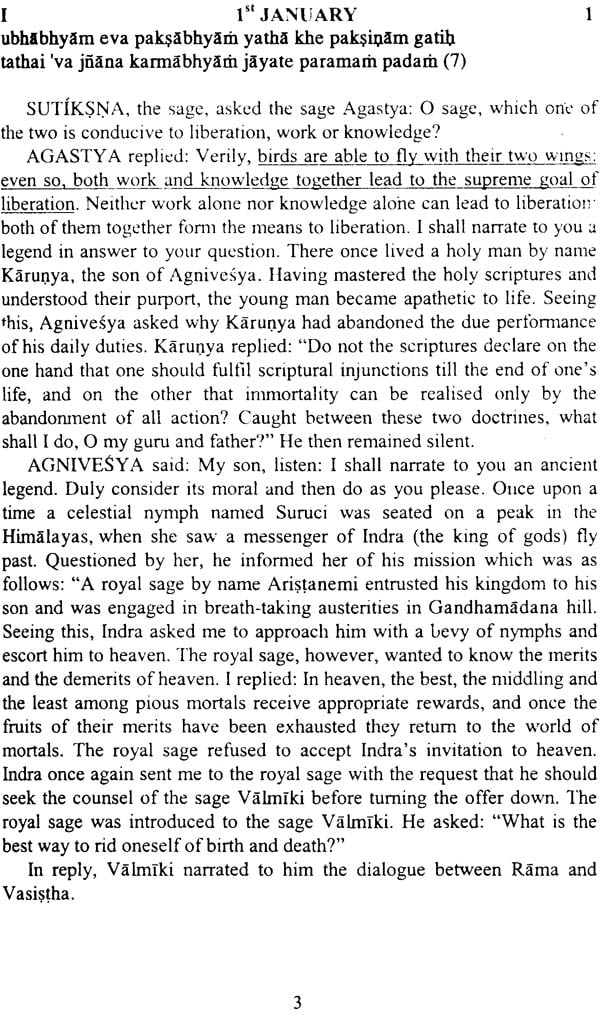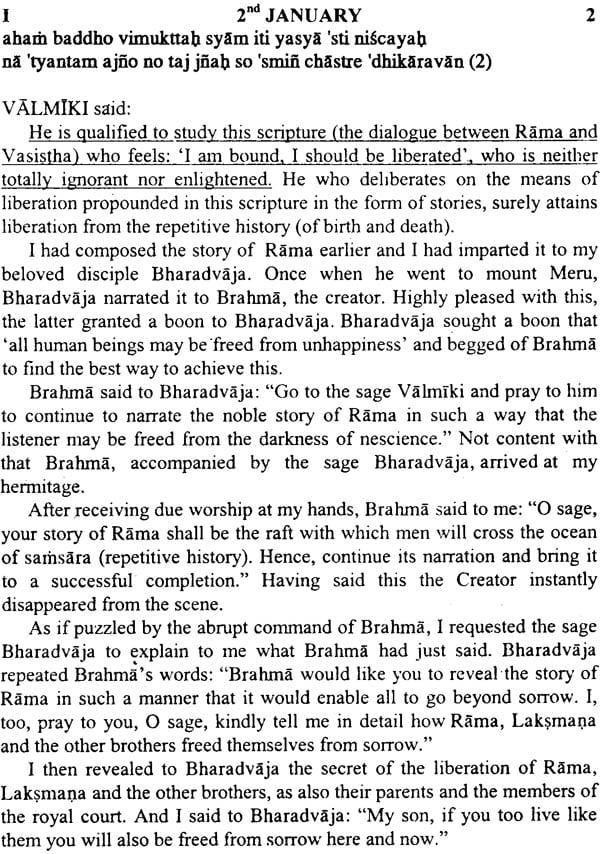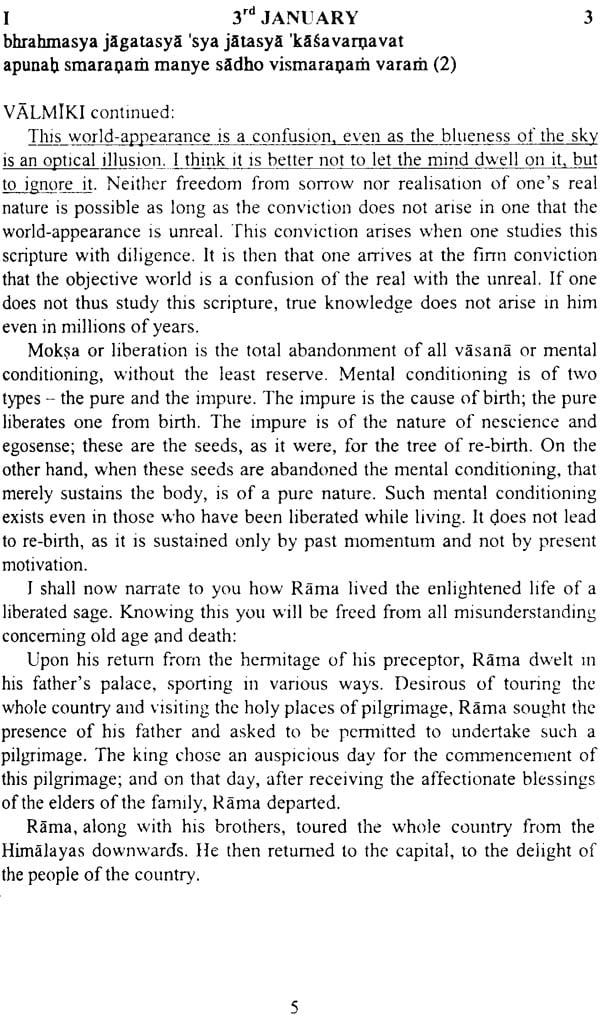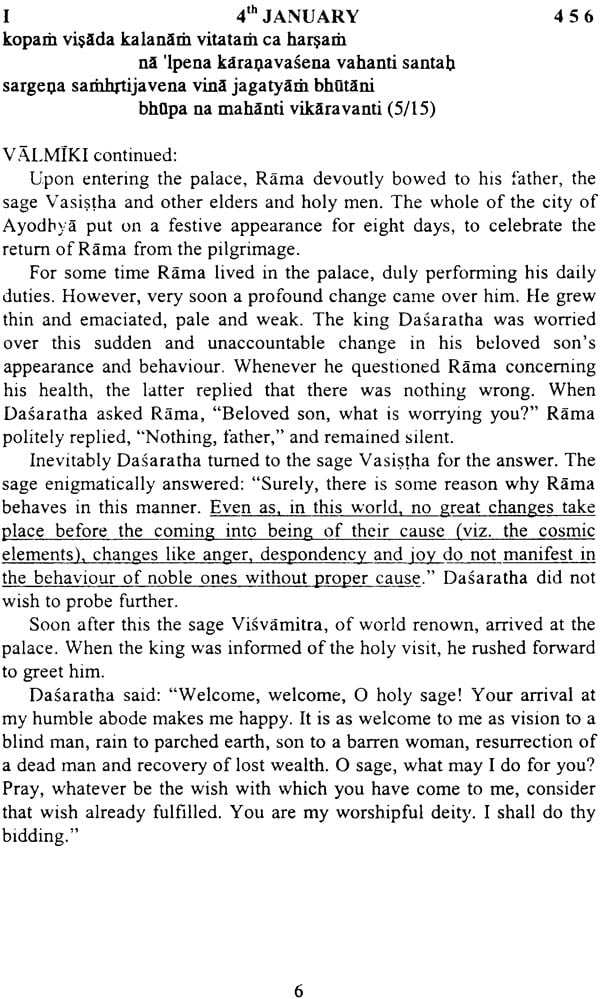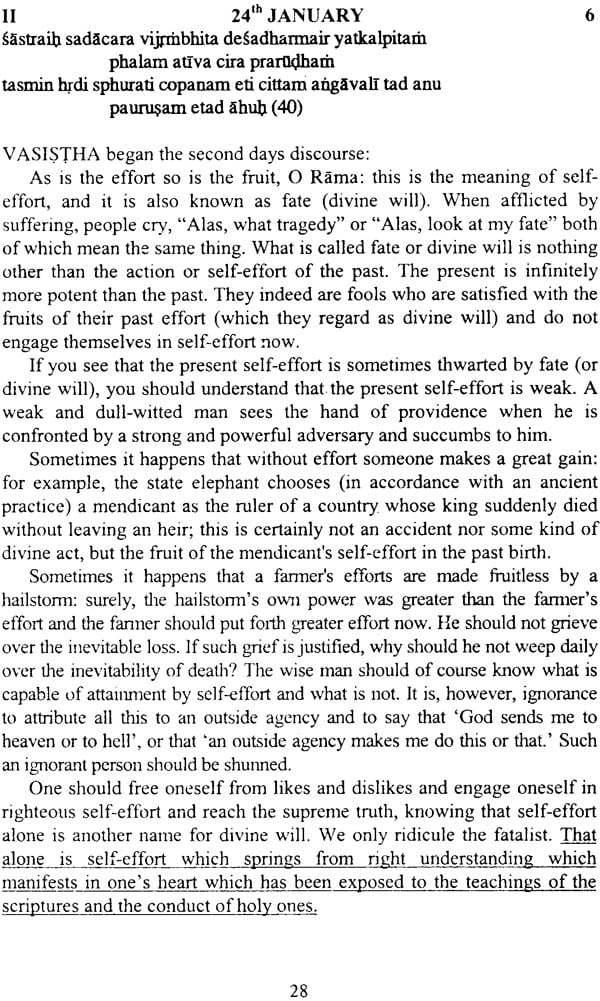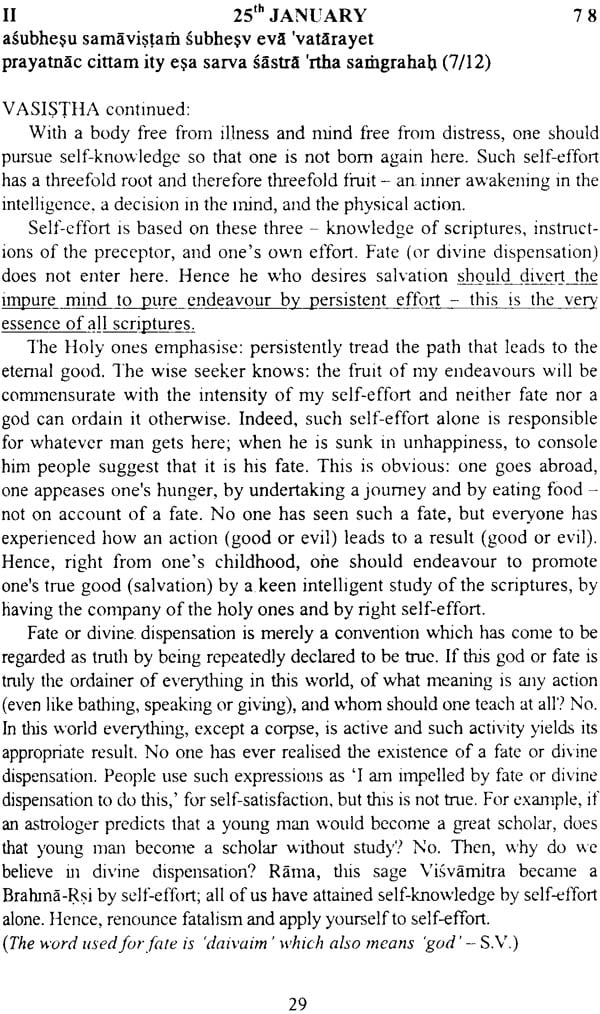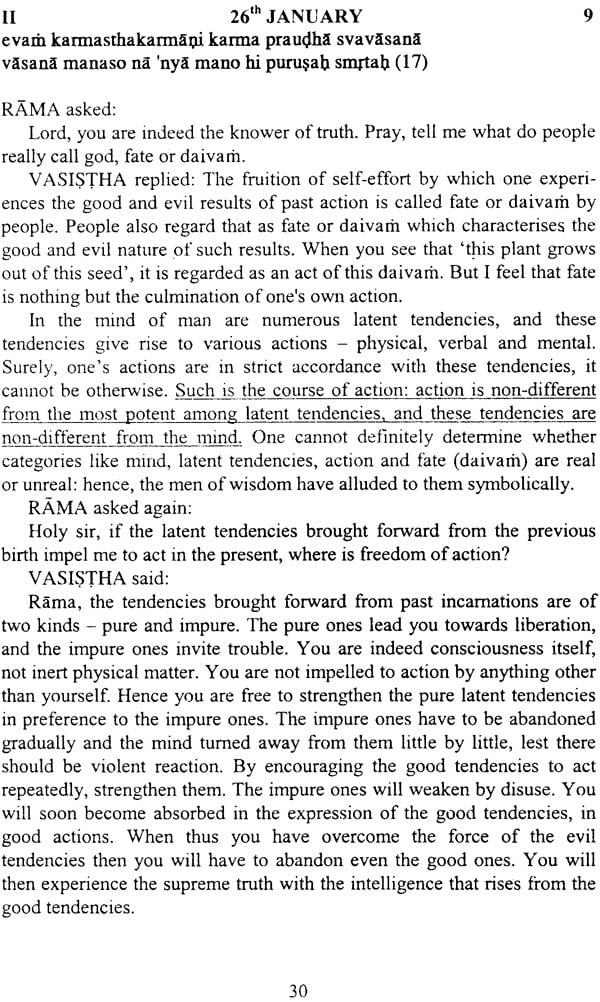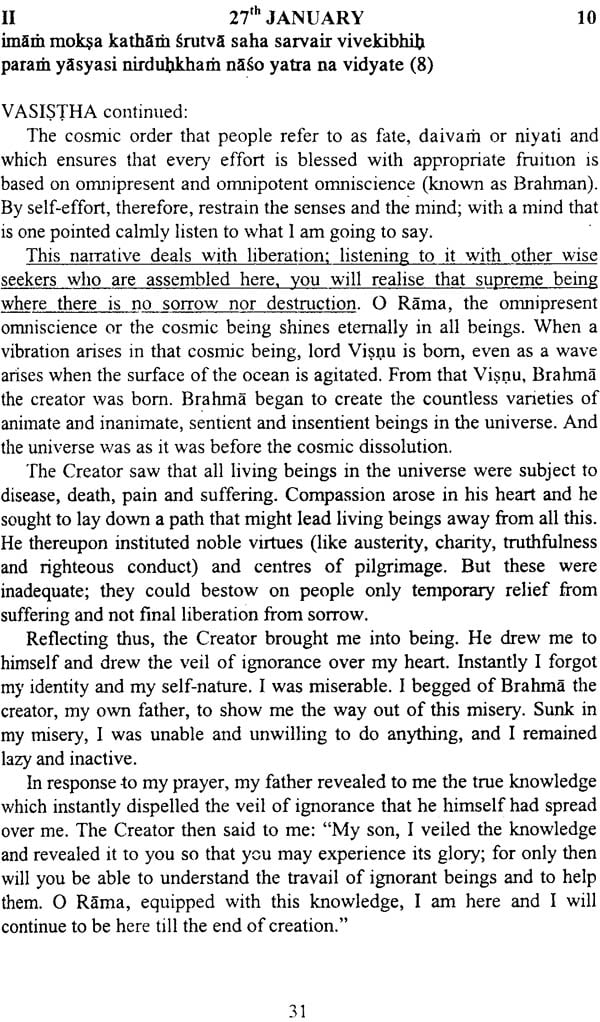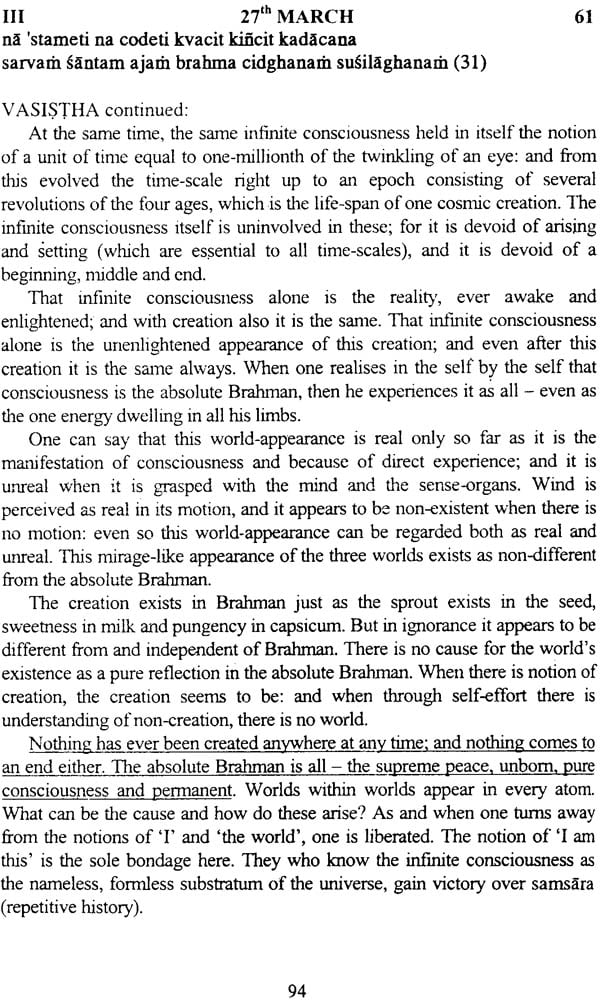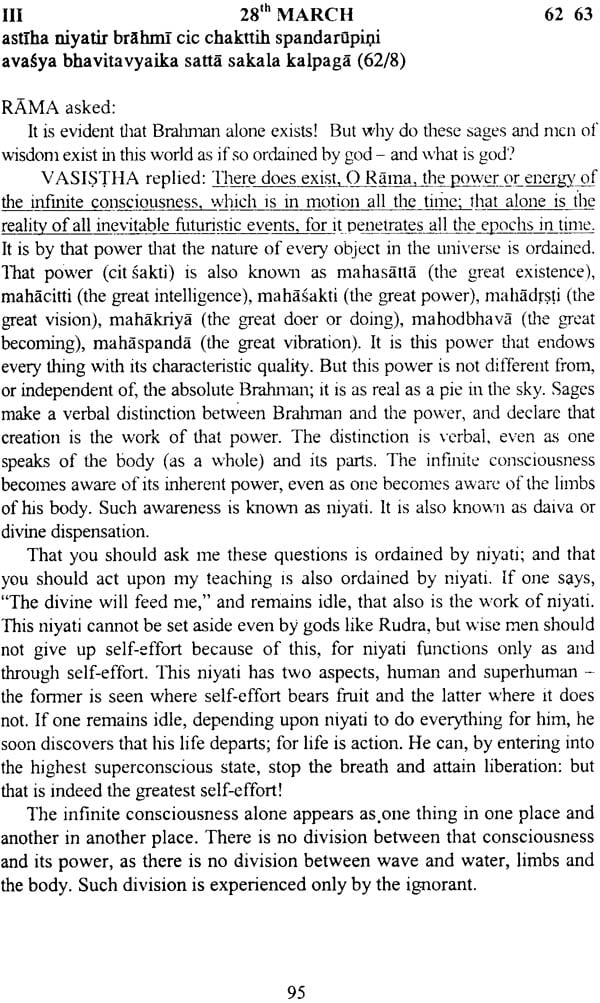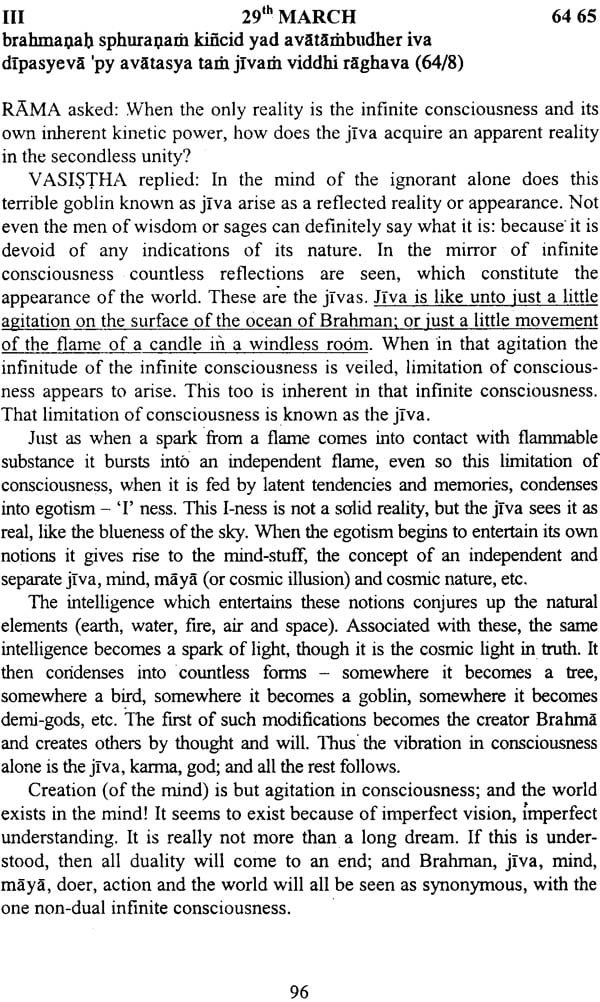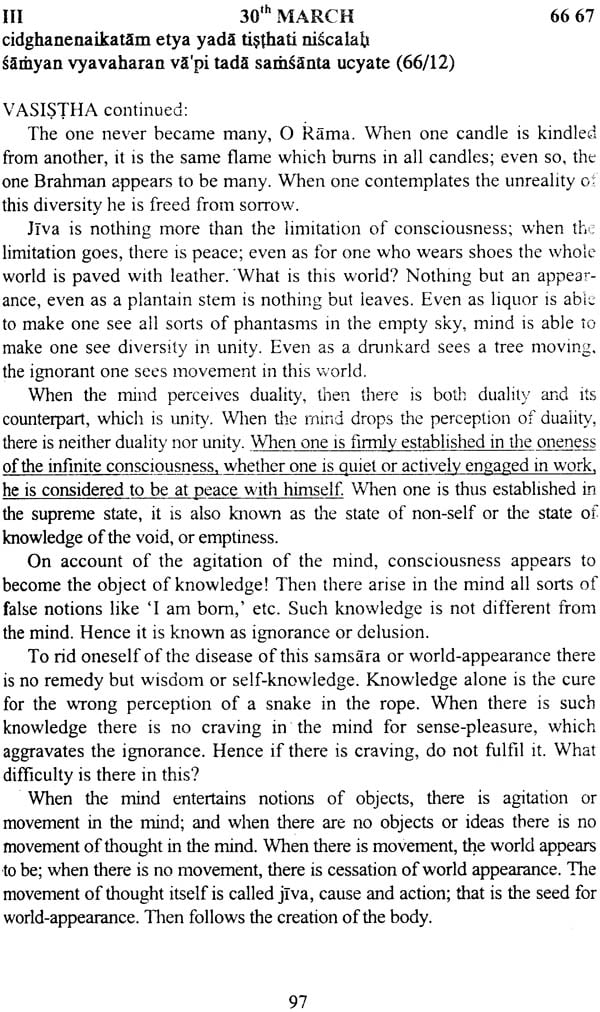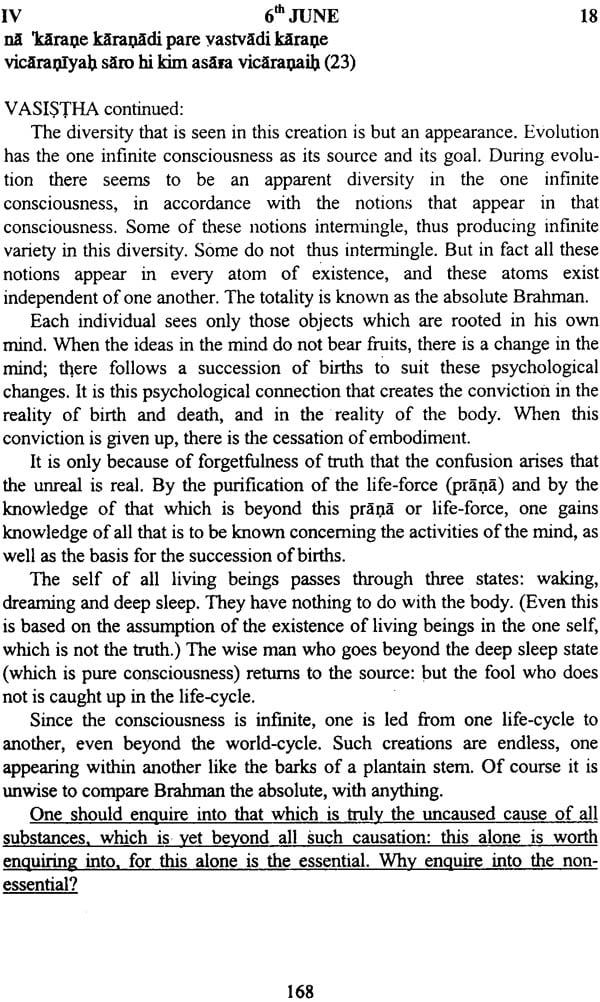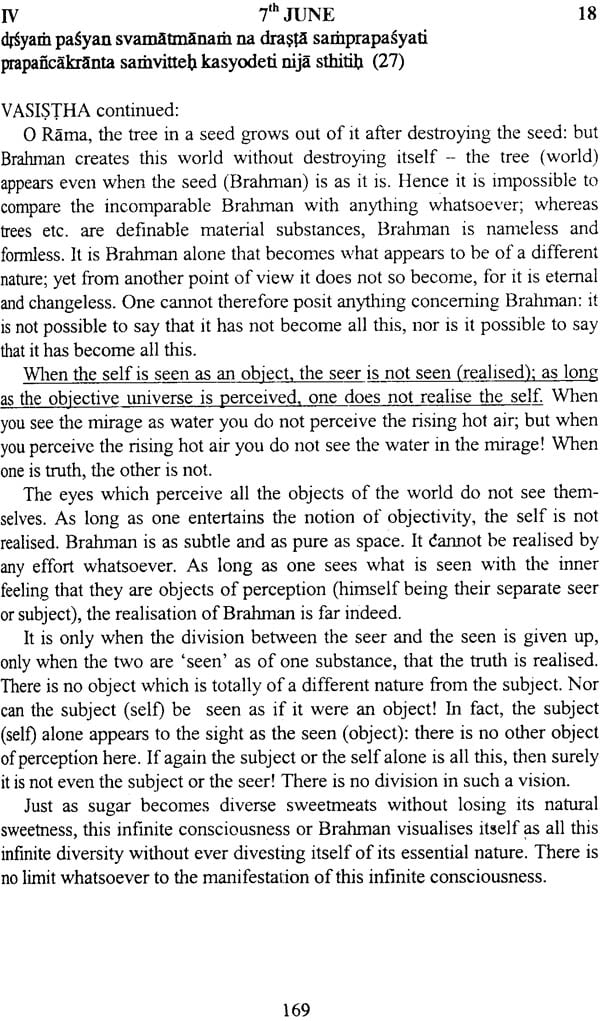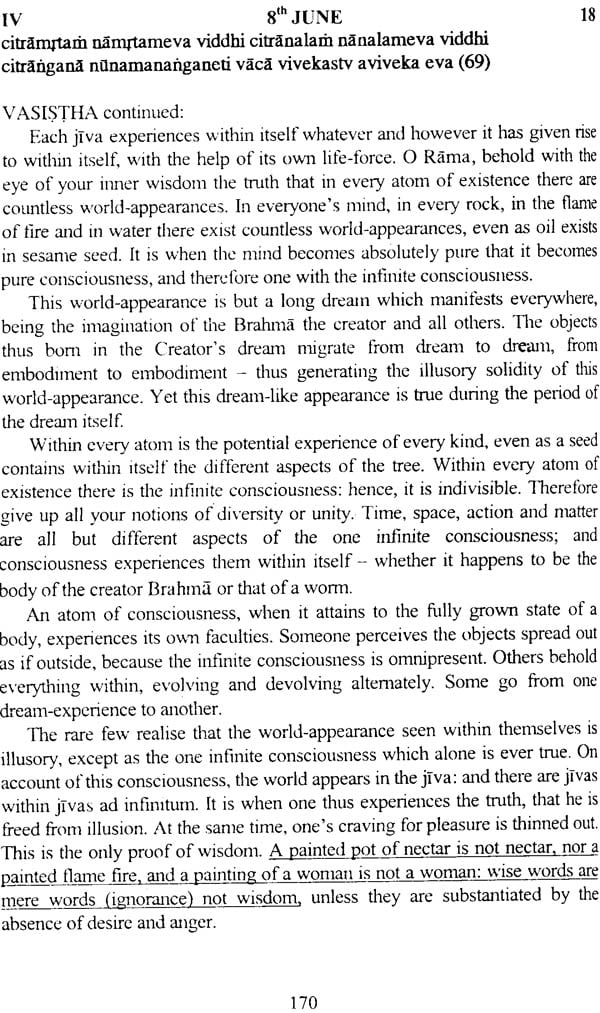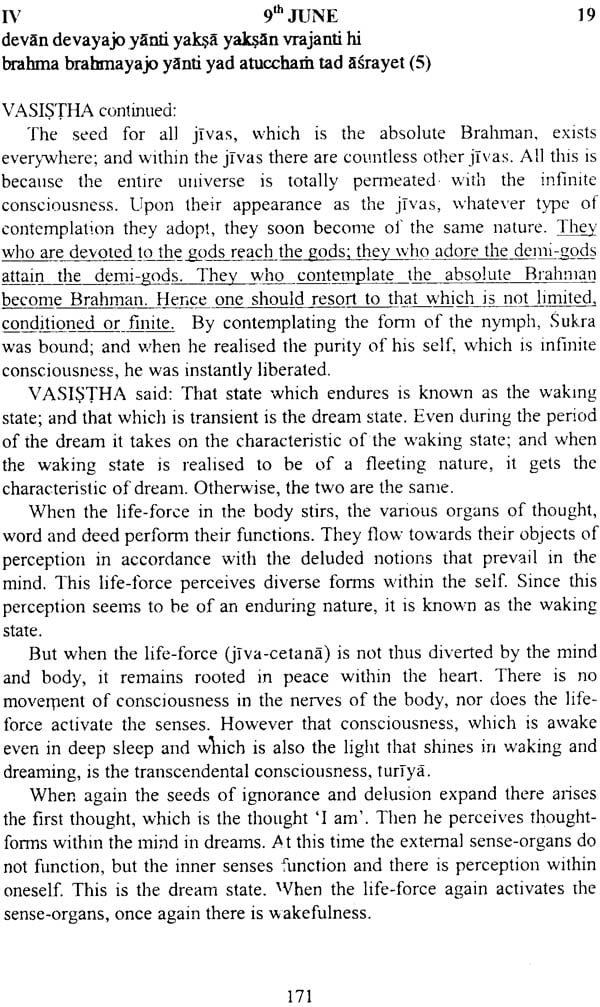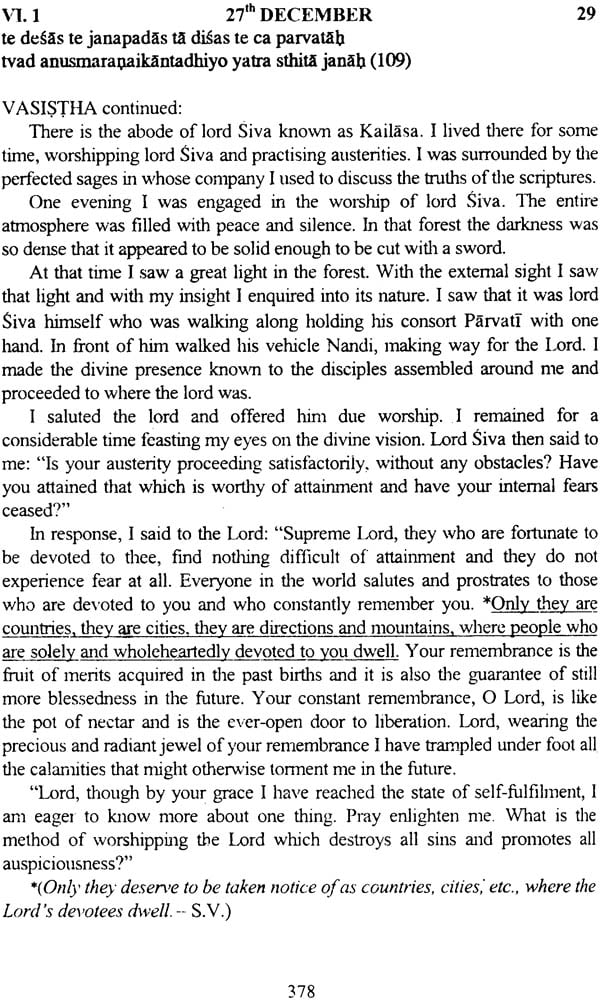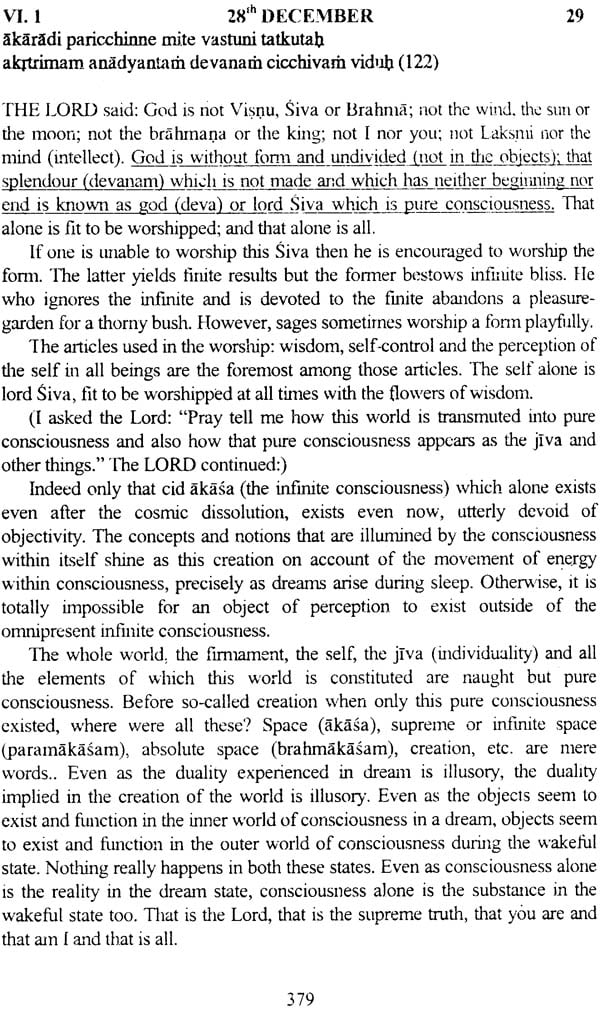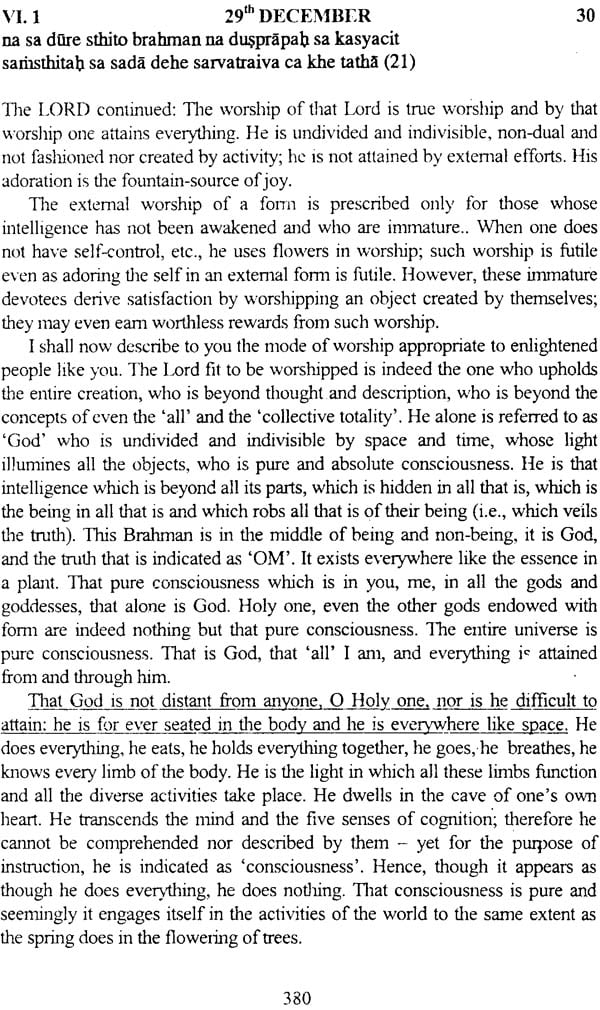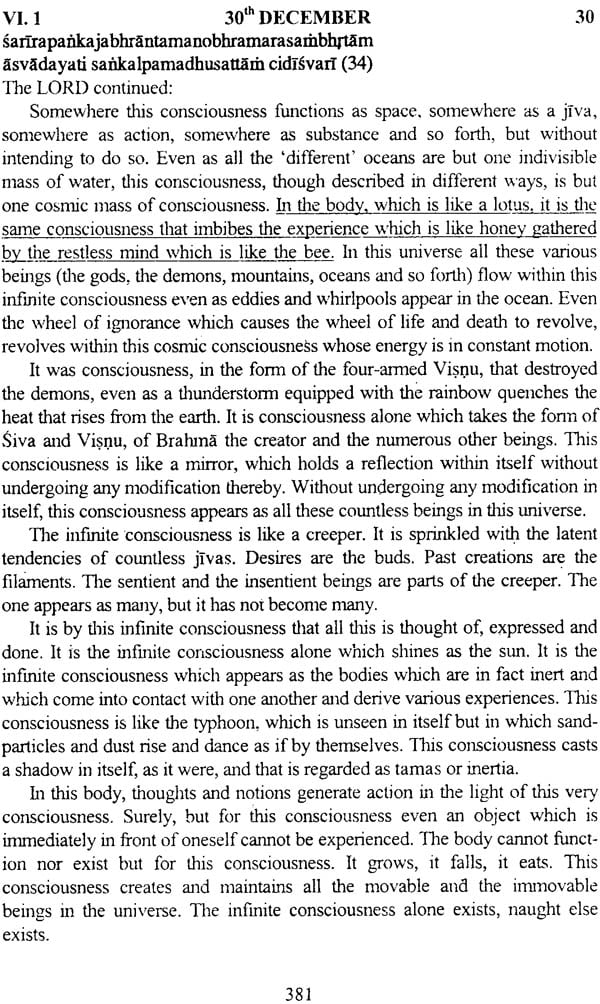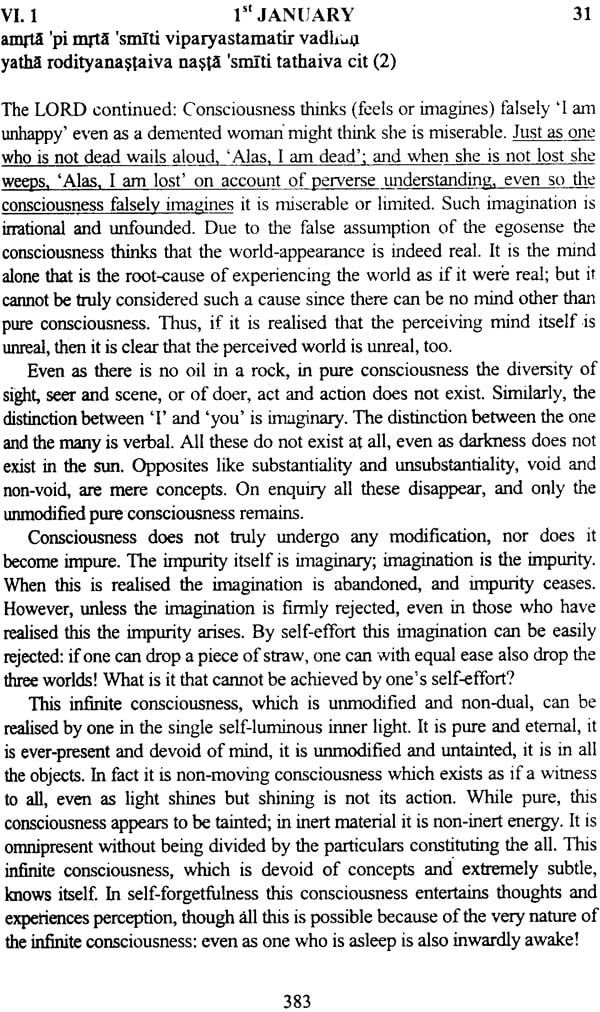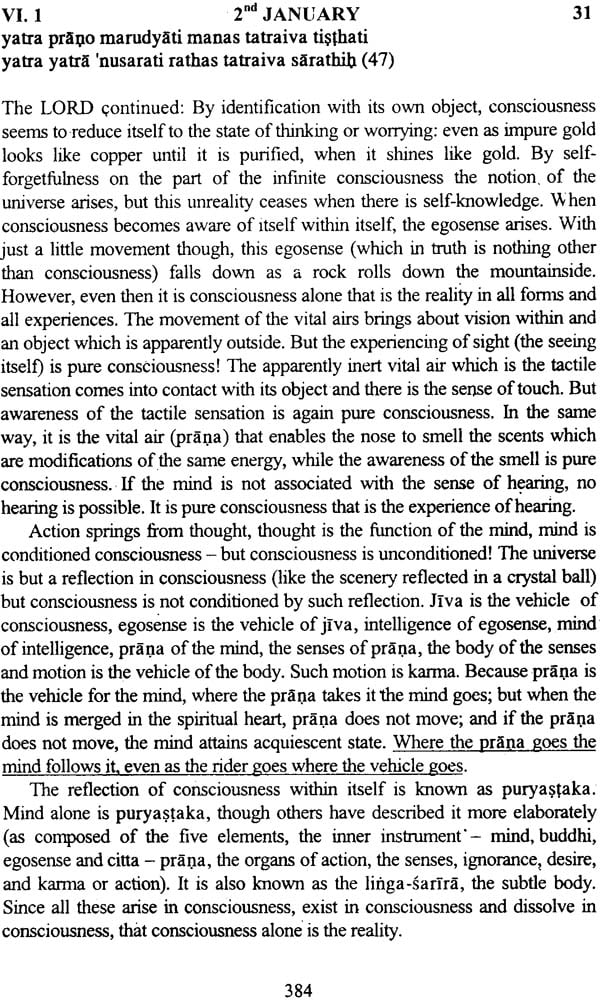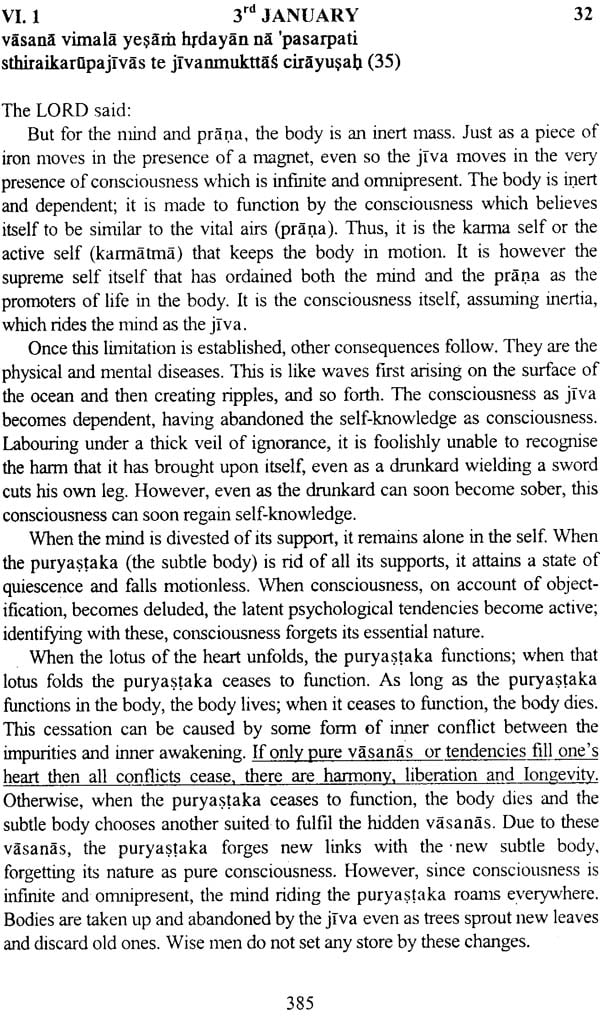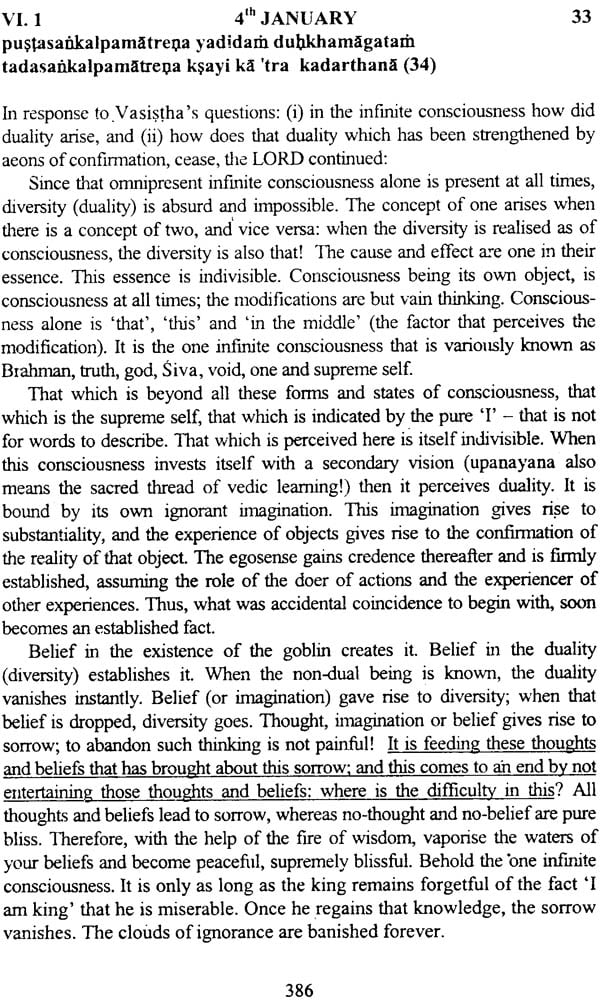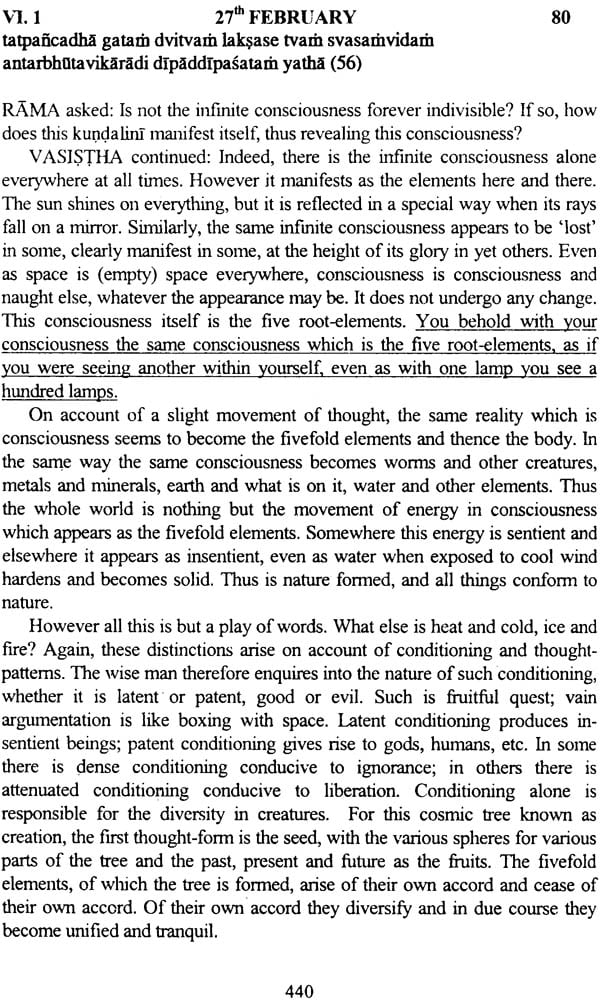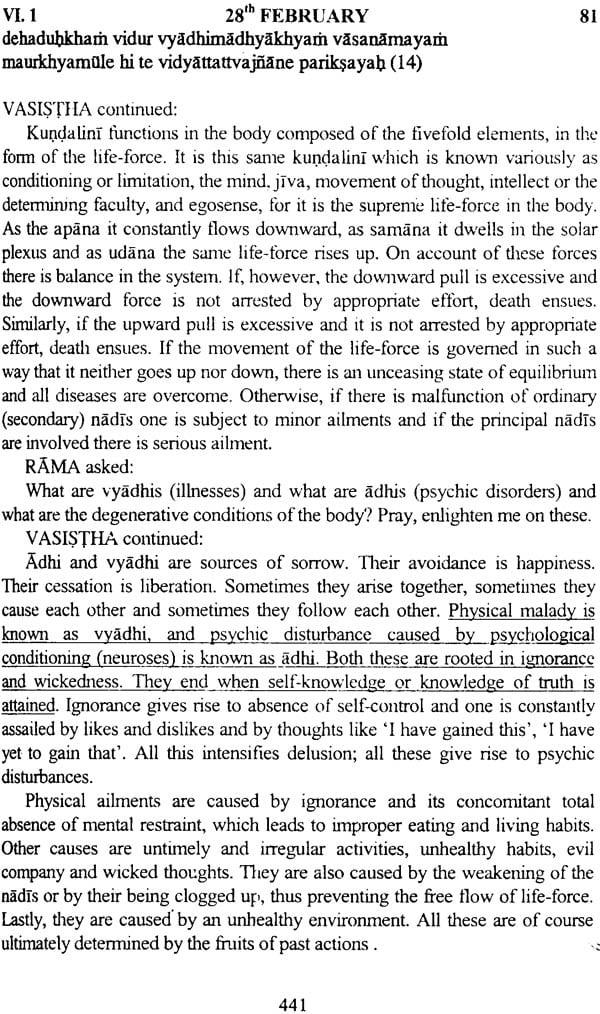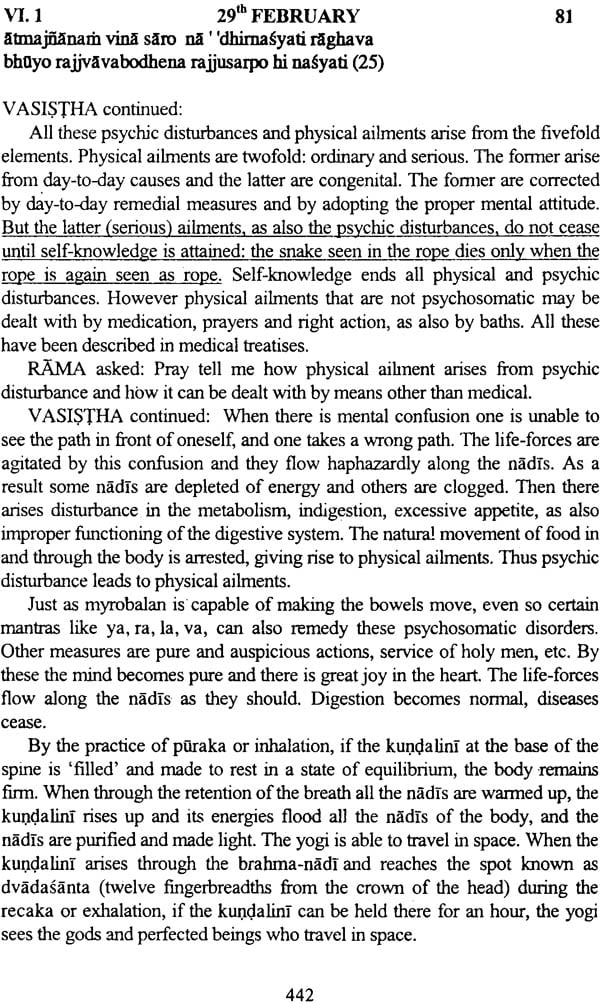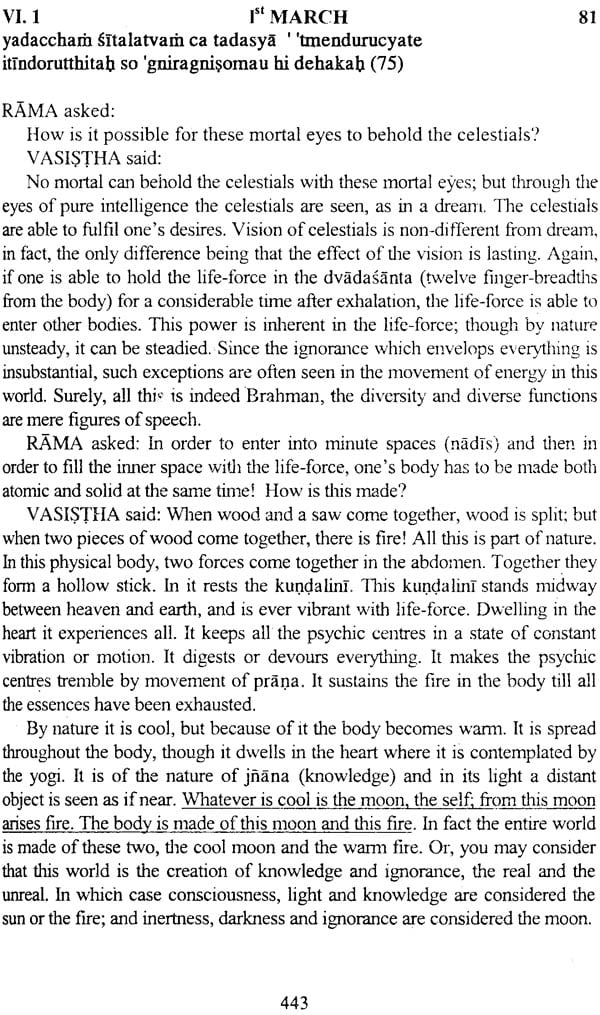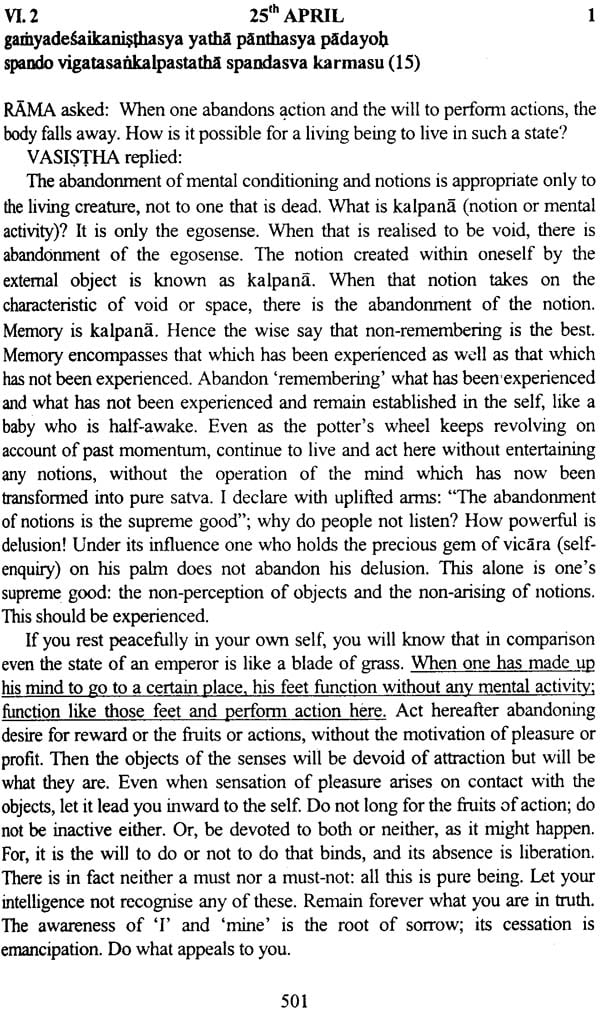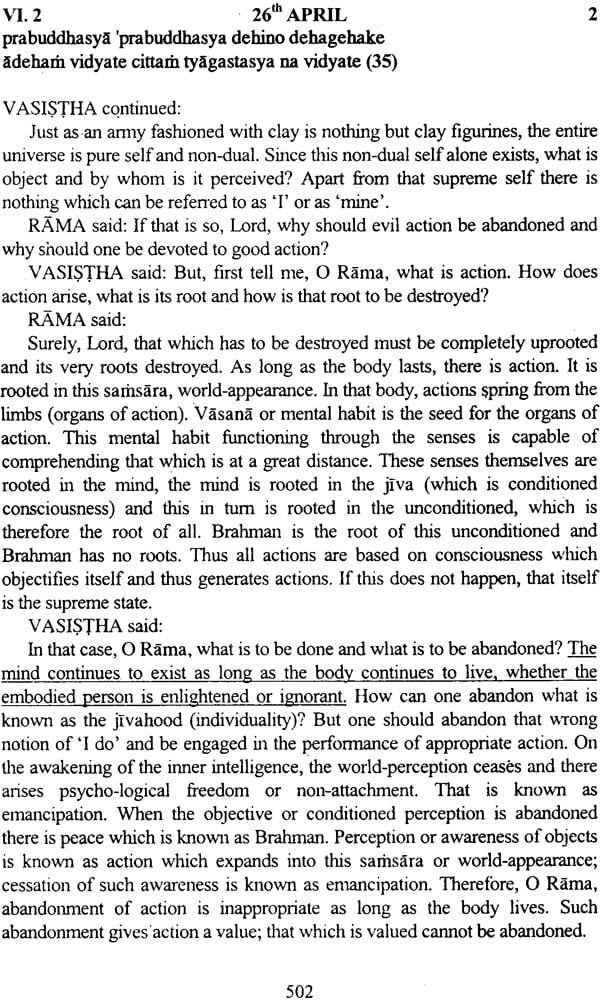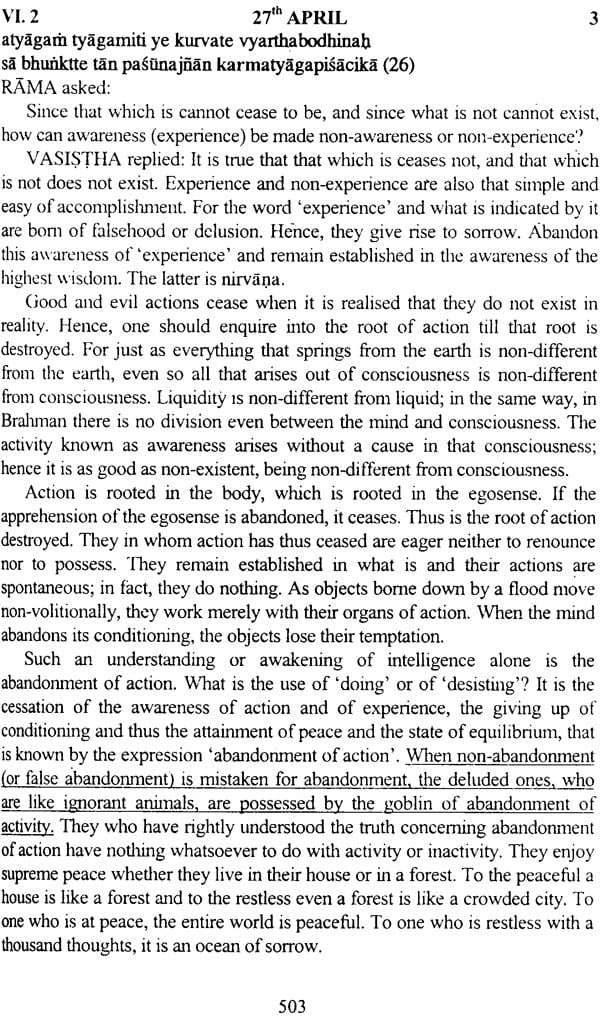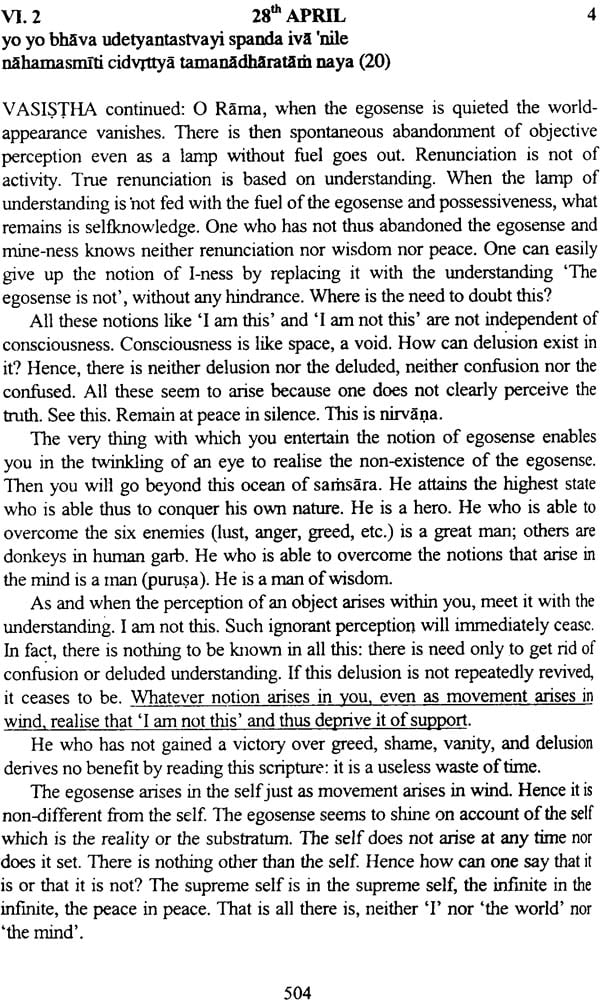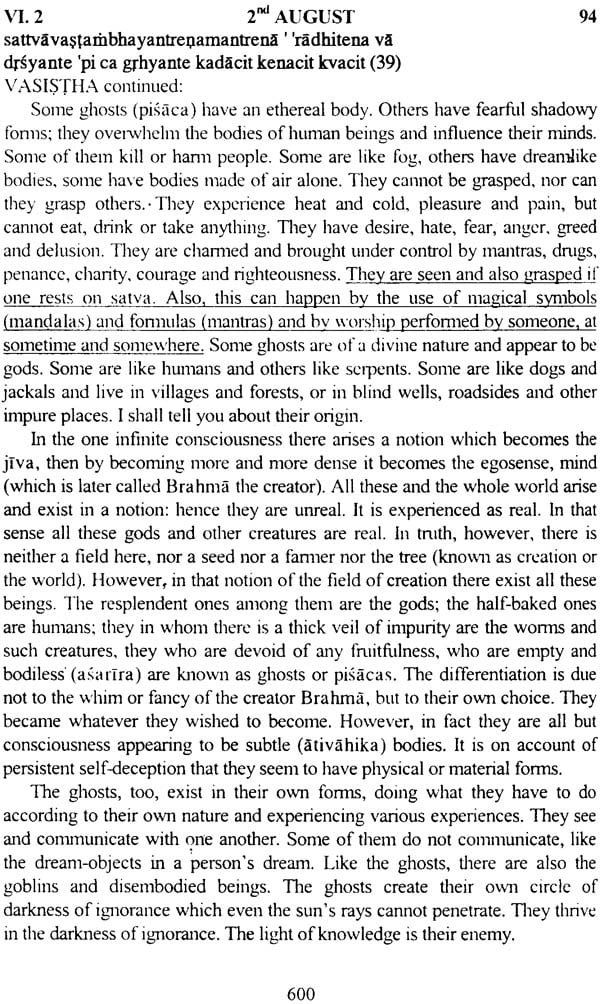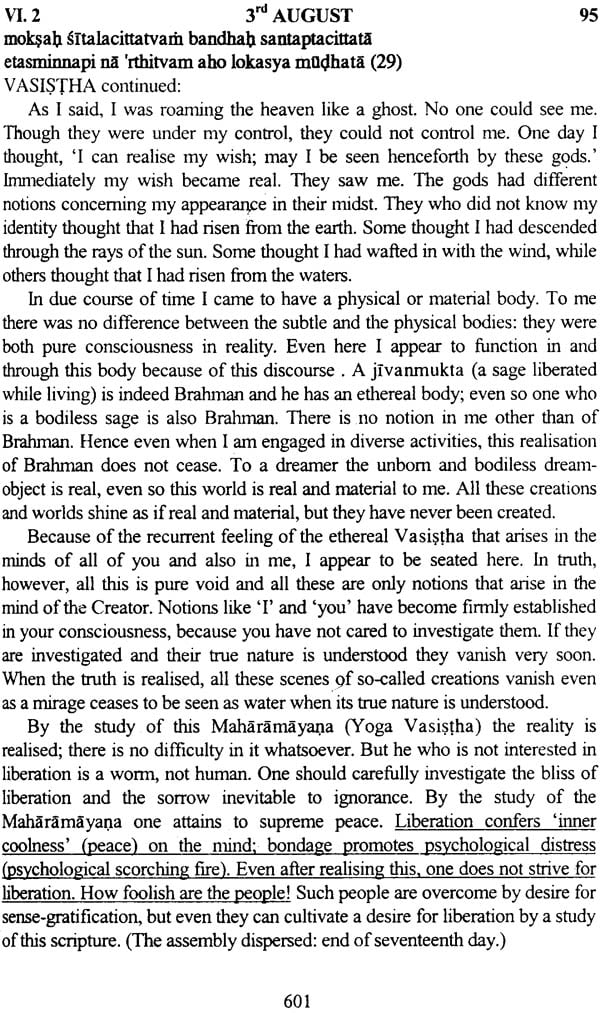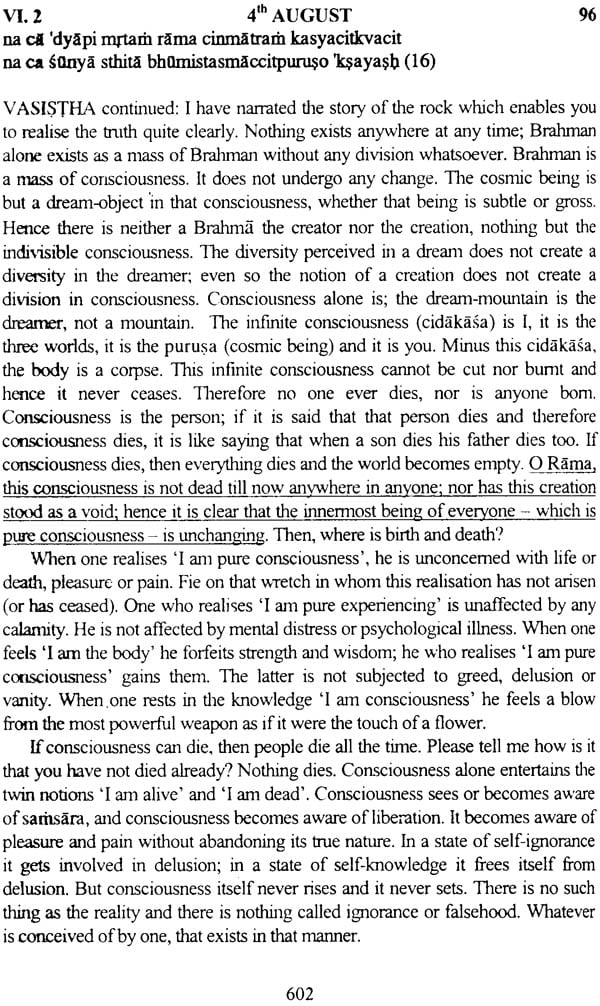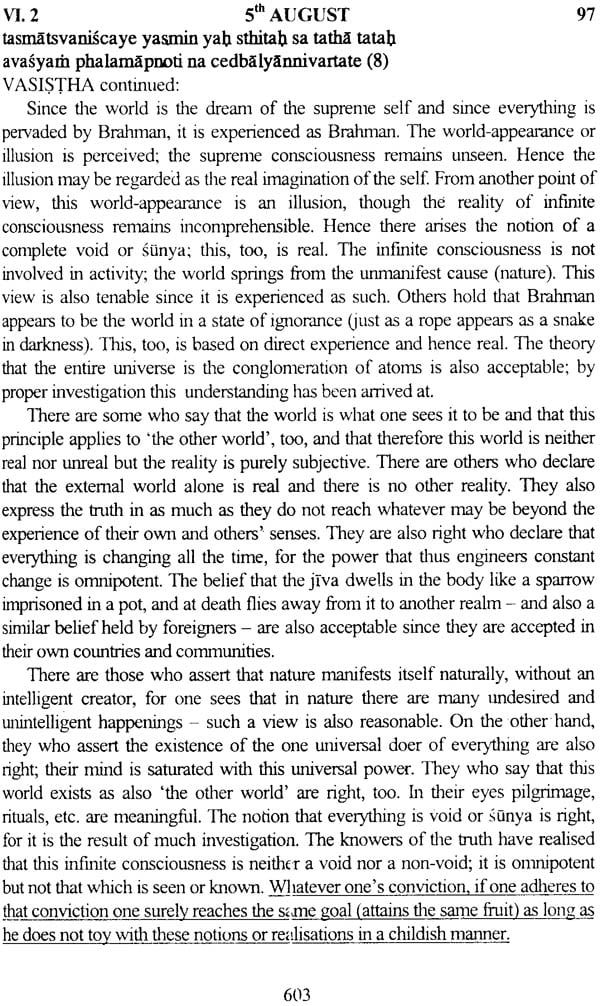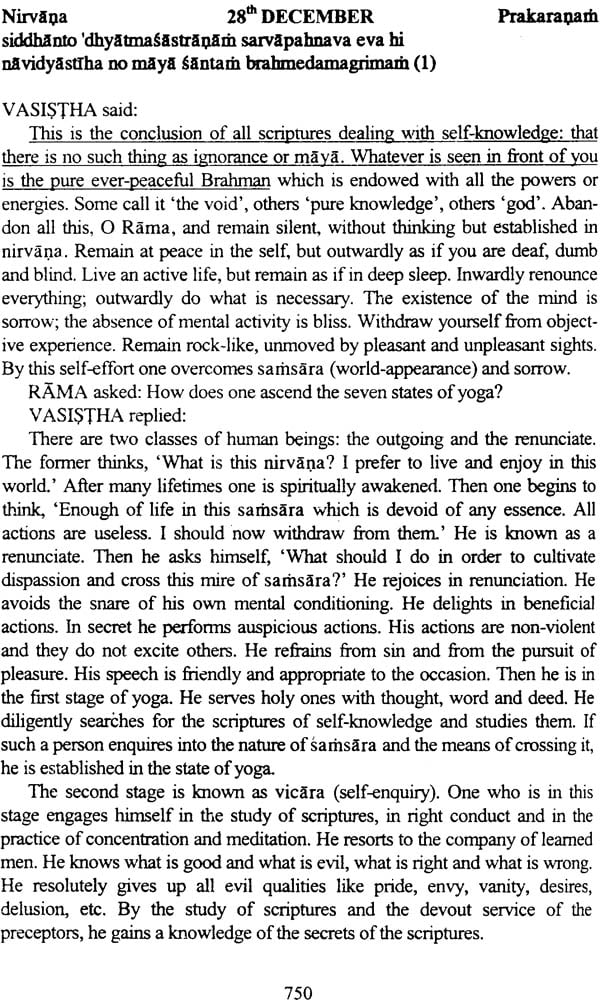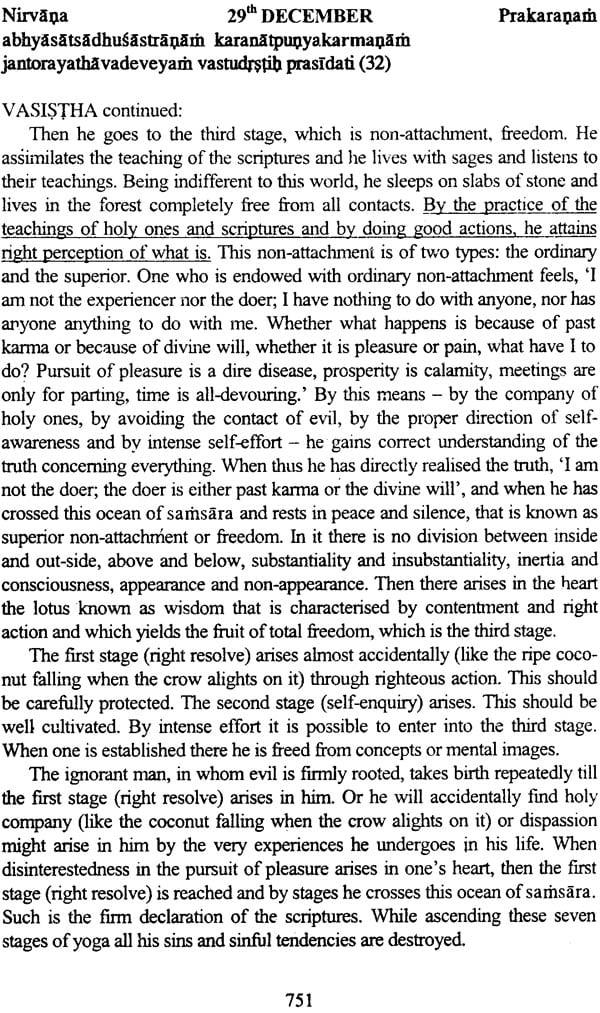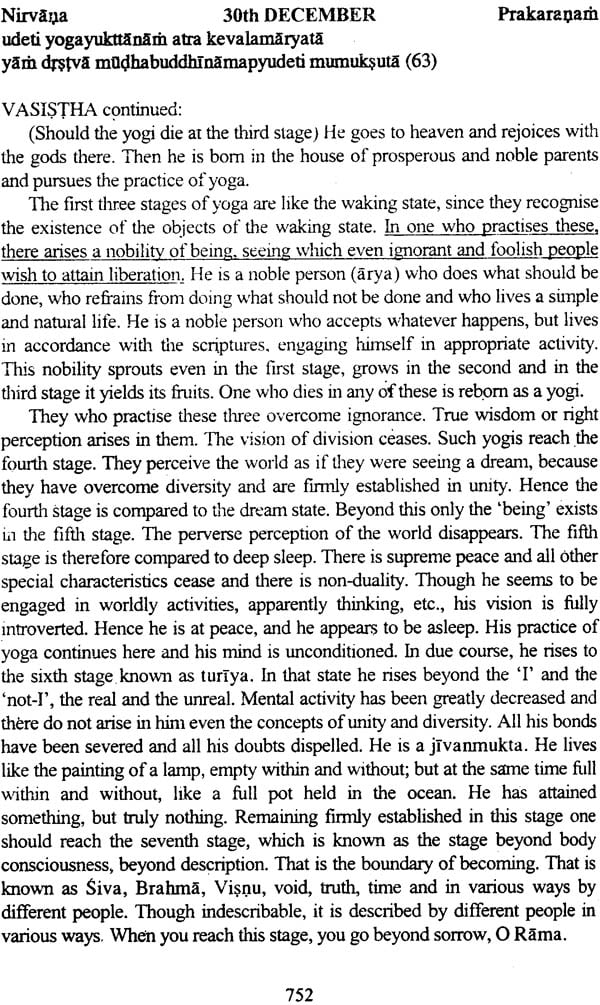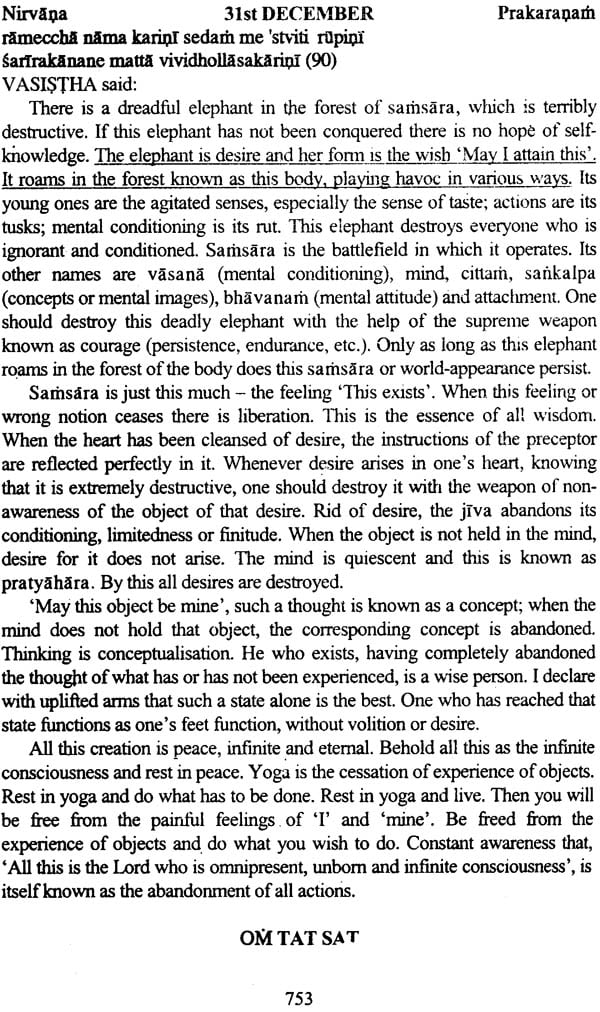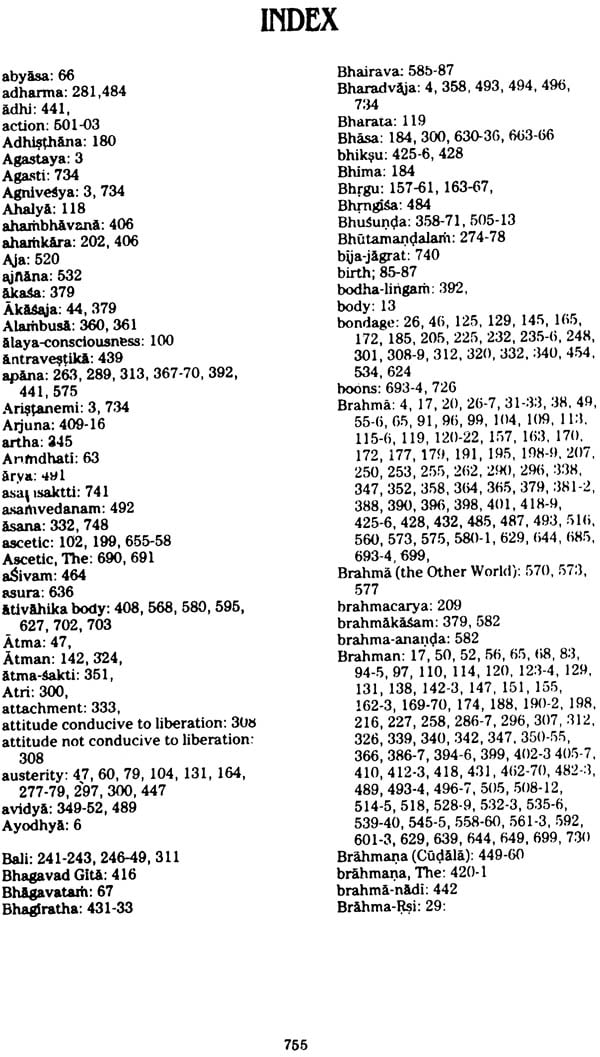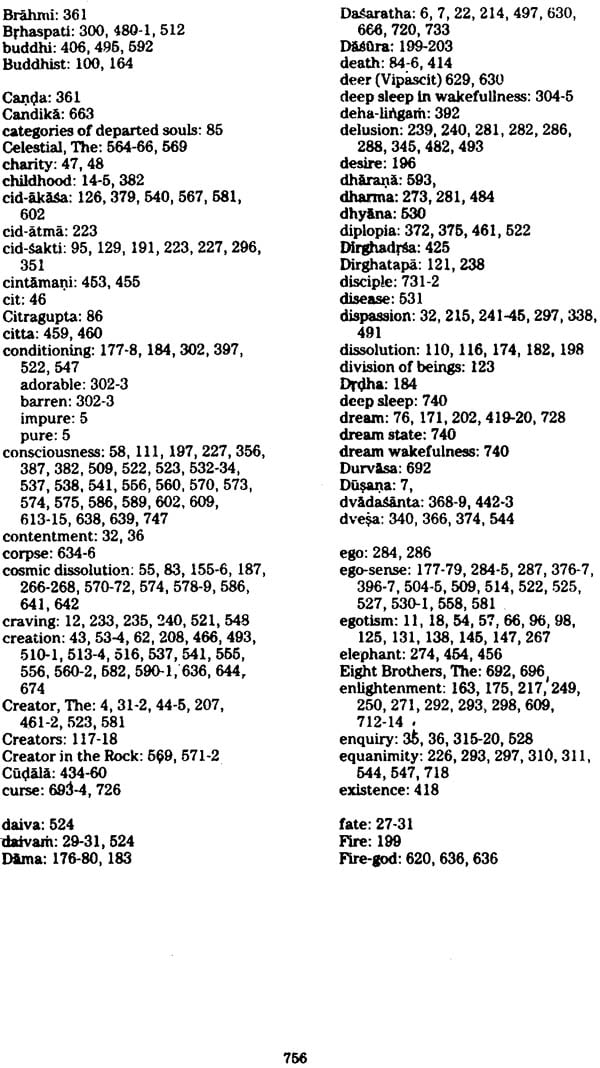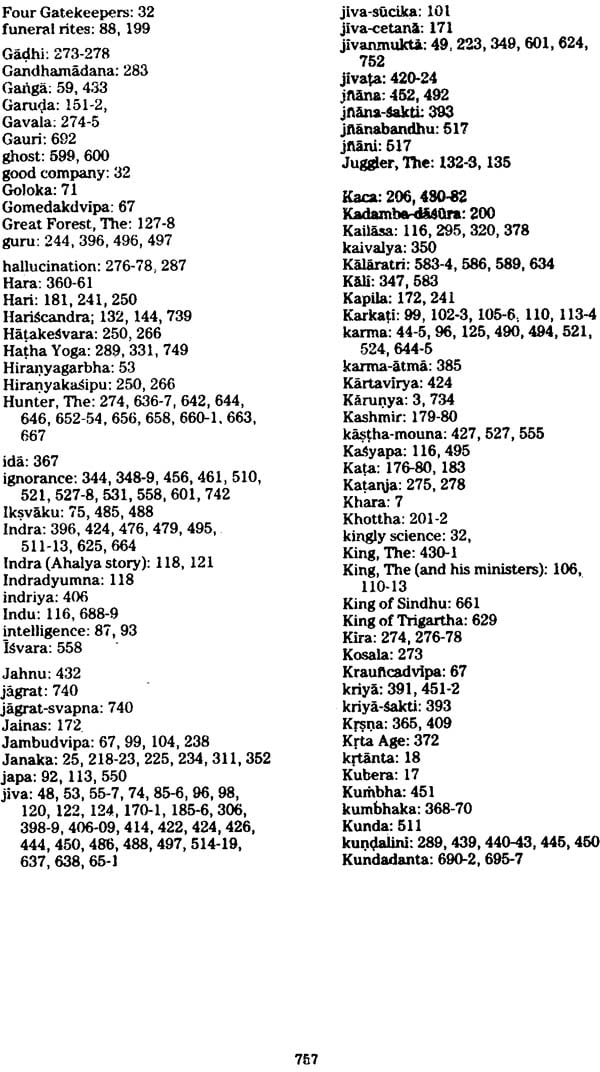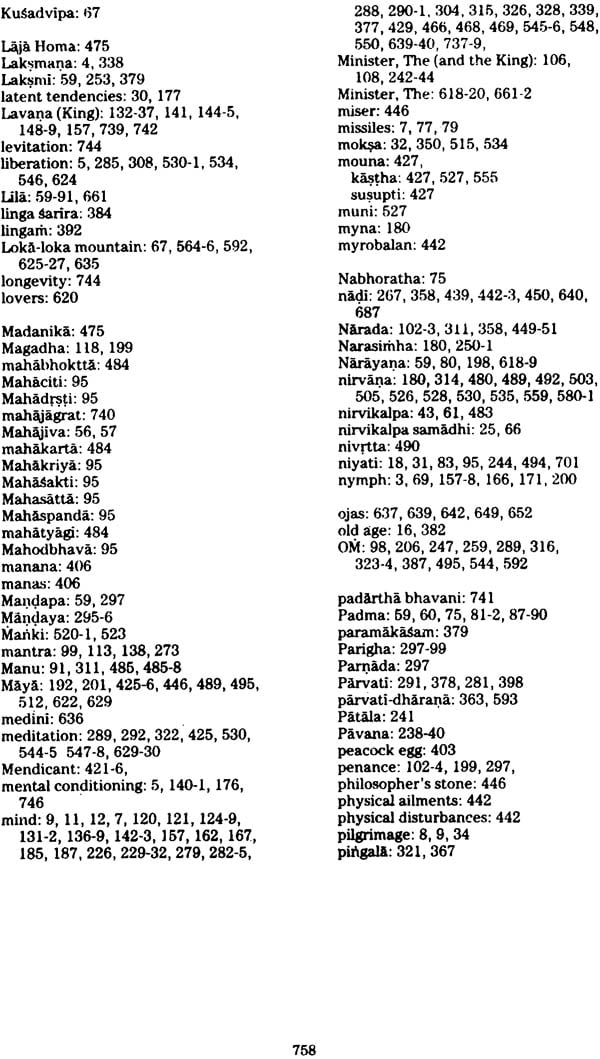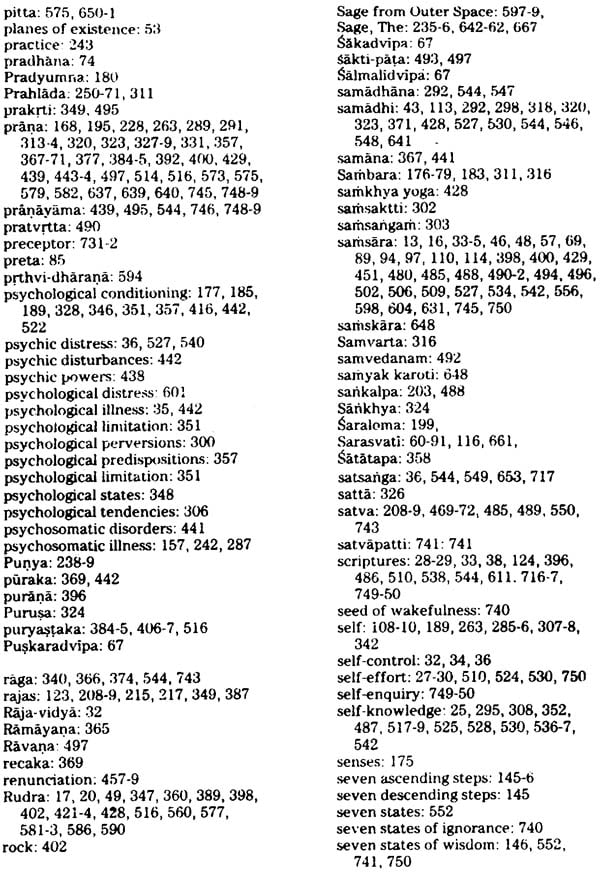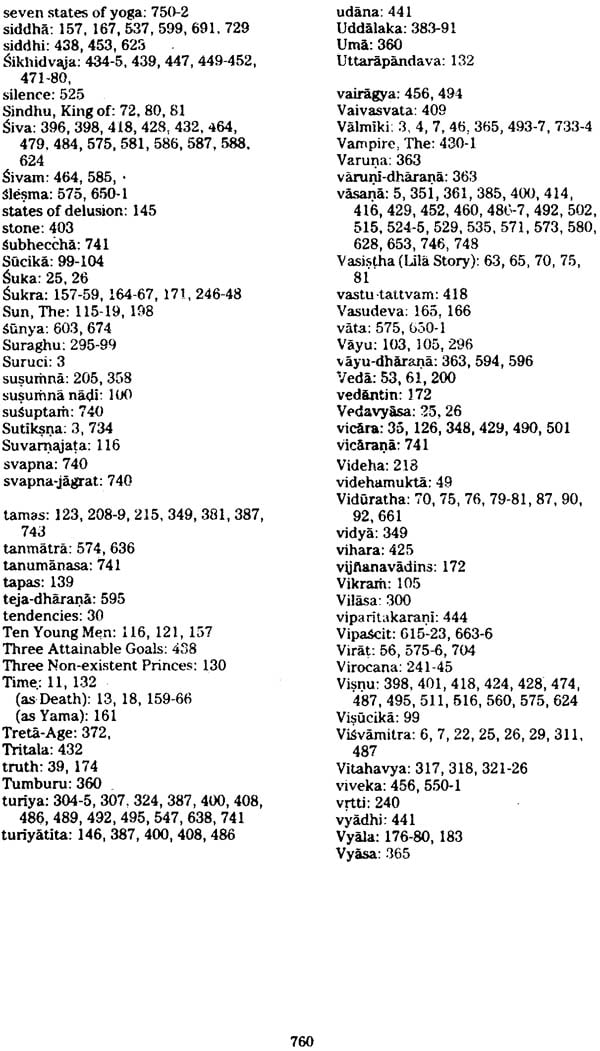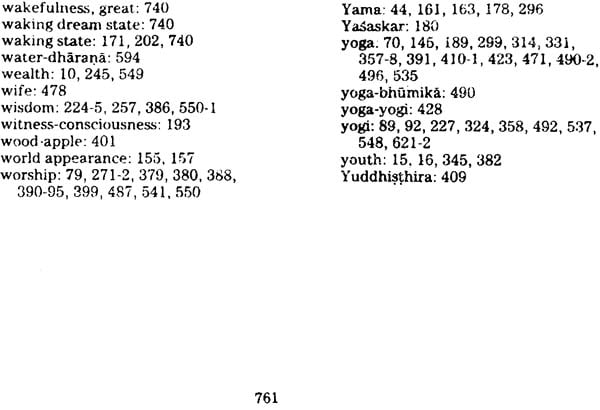
The Supreme Yoga: A New Translation of the Yoga Vasistha (Two Volumes)
Book Specification
| Item Code: | IDF290 |
| Author: | Swami Venkatesananda |
| Publisher: | New Age Books |
| Language: | Translation with With Transliterated Text |
| Edition: | 2000 |
| ISBN: | 9788178222608 |
| Pages: | 777 |
| Cover: | Paperback |
| Other Details | 8.4" X 5.4" |
| Weight | 1.02 kg |
Book Description
From the Back of the Book:
The Yoga Vasistha is a unique work of Indian philosophy and is highly respected for its practical mysticism. These teachings of Sage Vasistha imparted to Lord Rama, contain the true understanding about the creation of the world.
The Supreme Yoga, with Romanised text, is a translation into English of this complete work and is accompanied by brief expositions by Swami Venkatesananda.
This book brings this store house of wisdom to our world and makes the philosophy comprehensible to scholars and common people alike.
Soak into the message of each verse and discover the numerous ways in which this truth is revealed to help open your mind.
About the Author:
Swami Venkatesananda, has been working untiringly for decades to spread life-giving message of Yoga and Vedanta in the East and West. He is the author of, among others, the Srimad Bhagvatam or The Book of God and The Bhagavad Gita or The Songs of God.
The Yoga Vasistha has always been considered as perhaps the most elaborate exposition of Philosophy and Religion ever written under the sun. The work, which is voluminous in its nature, has been abridged by several scholars subsequently to make the treatise accessible to people who would not have the time and patience to wade through this large literature. Sri Swami Venkatesananda, a direct disciple of His Holiness Sri Swami Sivanandaji Maharaj, has, however, excelled the earlier precis writers on this subject in' his brilliant two-volume presentation of this Scripture under the title 'The Supreme Yoga'. The First Edition was published under the auspices of The Chiltern Yoga Trust, P.O. Elgin, Cape Province, South Africa, in two excellently printed volumes.
Now, the Fourth Edition of this veritably standard work is being published by The Divine Life Society Headquarters for the benefit of all seekers of Truth and the general readers of spiritual teachings. We have a firm hope that this well-known, towering teaching will provide to everyone the requisite inspiration and solace.
This Edition is pecially dedicated to the sacred memory of H:H. Sri Swami Dayanandaji Maharaj who attained Maha Samadhi on 4.2.2002. He will be remembered by Gurudev Swami Sivanandaji Maharaj's spiritual fraternity as one who has rendered invaluable service to the Institution in various capacities, besides being the chief architect of the printing establishment at the Headquarters Ashram.
This book. The Supreme Yoga, is a translation into English. accompanied by brief expositions. by Swami Venkatesananda of the Divine Life Society. Rishikesh. India. of the well-known Vedanta treatise in Sanskrit. The Yoga Vasistha.
The Swami has arranged the verses of the book in such a way as to convert them into a rosary of daily thoughts throughout the year. on the lines of his two other books already published, namely The Srimad Bhagavatam or Book of God and The Bhagavad Gita or The Song of God.
The Yoga Vasistha has been a favourite book of spiritual seekers in India these Several centuries Its special appeal lies in its thoroughly rational approach. and in its presentation of Vedanta as a philosophy which dares. like the The Bhagavad Gita, to bridge the gulf between the secular and the sacred action and contemplation. in human life. through a comprehensive and lofty spirituality. The reader will come across passages such as the verse entry for 31 st January. highlighting the importance of reason:
"The remark of even a child is to be accepted. if it is in accordance with reason: but the remark of even Brahma Himself: the creator of the world, is to be rejected like a piece of straw, if it does not accord with reason."
It is this philosophy of a comprehensive spirituality. rational and prac- tical. that man in the modern age needs to rescue himself from his stagnation of worldliness and put him on the high road of creative living and fulfilment.
Swami Venkatesananda. who has been working untiringly for decades to spread the life-giving message of Yoga and Vedanta in East and West, has done a great service to spiritual seekers far and wide by bringing out this translation of The Yoga Vasistha in the wake of his translation of the other two great books.
The Chiltern Yoga Trust of Elgin. South Africa, deserves the silent thanks of readers for publishing these three books of the Swami and helping to broadcast far and wide the life-giving, purifying. and inspiring ideas of Eternal India. Amar Bharat, in her Vedanta.
Scholars speculate about the author of this monumental scripture and such other academic matters: may God bless them with success.
The Yoga Vasistha is the greatest help to the spiritual awakening and the direct experience of the Truth. This is certain. If this is what you want, YOU are welcome to the Yoga Vasistha.
The text abounds in repetitions which are, however, not repetitious. If you do not like (or need) repetition, then readjust this one verse: "This world appearance is a confusion: even as the blueness of the sky is an optical illusion. I think it is better not to lei the mind dwell 011 it. but to ignore it. "(I - 3/2) "
This verse occurs several times in the scripture and it sems to be the very essence of the teaching. If that is not quite clear to you now, read the scripture. The numerous ways in which this truth IS revealed will help open your mind.
It is wise to read just one page per day. The teaching is revolutionary. The biased mind docs not readily accept it. After the daily reading, meditate. Let the message soak through.
An oft recurring expression in this scripture is 'kakataliya' - a crow alights on the coconut palm tree and at that very moment a ripe coconut falls. The two unrelated events thus seem to be related in time and space, though there is no causal relationship.
Such is life. Such is 'creation'. But the mind caught up in 'its own trap of logic questions why, invents a 'why' and a 'wherefore' to satisfy itself, conveniently ignoring• the inconvenient questions that still haunt an intelligent mind.
| Preface | V | |
| Foreword | VII | |
| Introduction | IX | |
| Scheme of Transliteration | XI | |
| Prayer | XIII | |
| 1. | | |
| Section Dealing with Dispassion | 1-22 | |
| II. | | |
| The Behaviour of the Seeker | 25-39 | |
| 1. The Story of Suka | 1-26 | |
| 2. The Four Gate-Keepers | 32-36 | |
| III. | | |
| Section Dealing with Creation | ||
| 1. The Story of Ajasaja (The holy man) | 44 | |
| 2. The Story of Lila | 59-91 | |
| 3. The Story of Karkati | 99-114 | |
| 4. The Story of the Sons of Indu (Ten Young Men) | 116-117 | |
| 5. The Story of Ahalya | 118-119 | |
| 6. The Story of the Great Forest | 127-128 | |
| 7. The Story of the Three Non-existent Princes | 130 | |
| 8. The Story of Lavana | 132-149 | |
| IV. | | |
| Section Dealing with Existence | 155-209 | |
| 1. The Story of Sukra | 157-167 | |
| 2. He Sees the Truth | 174 | |
| 3. The Story of Dama, Vyala and Kata | 176-184 | |
| 4. The Story of Bhima, Bhasa and Drdha | 184 | |
| 5. The Story of Dasura | 199-204 | |
| 6. Kaca's Song | 206 | |
| V. | | |
| Section Dealing with Dissolution | 213-333 | |
| 1. The Story of King Janaka | 218-225 | |
| 3. The Story of Bali | 241-249 | |
| 4. The Story of Porahlada | 250-271 | |
| 5. The Story of Gadhi | 273-278 | |
| 6. This Mind | 282 | |
| 7. The Story of Uddalaka | 283-291 | |
| 8. The Story of Suraghu | 295-299 | |
| 9. The Story of Bhasa and Vilasa | 300-301 | |
| 10. The Story of Vitahavya | 317-324 | |
| VI. | | |
| Section Dealing with Liberation - VI.1 | 332-497 | |
| 1. Discourse on Brahman | 352-357 | |
| 2. The Story of Bhusunda | 358-372 | |
| 3. Description of the Lord | 378-391 | |
| 4. Deva Puja (Worship of God) | 391-395 | |
| 5. The Story of the Woodapple | 401 | |
| 6. The Story of the Rock (The Nature Consciousness) | 402-403 | |
| 7. The Story of Arjuna | 409-416 | |
| 8. The Story of the Hundred Rudra | 420-424 | |
| 9. The Story of the Vampire | 430-431 | |
| 10. The Story of Bhagiratha | 432-433 | |
| 11. The Story of Sikhidhvaja and Cudala | 434-480 | |
| 12. The Story of the Philosopher's Stone | 446 | |
| 13. The Story of the Cinntamani | 453-455 | |
| 14. The Story of the Foolish Elephant | 454-456 | |
| 15. The Story of Kaca | 480-486 | |
| 16. The Story of the Deluded Man | 482 | |
| 17. The Story of Bhrngisa | 484 | |
| 18. The Story of Iksvaku | 485-488 | |
| 19. The Story of Bharadvaja | 494-496 | |
| Section Dealing eith Liberation - VI.2 | 501-734 | |
| 20. The World Within the Rock | 559-602 | |
| 21. The Story of the Sage from Outer Space | 597-599 | |
| 22. The Story of Vipascit | 615-638 | |
| 23. The Story of Bhasa | 630-636 | |
| 24. The Story of Kalaratri | 634-635 | |
| 25. The Story of the Hunter and the Sage | 636-663 | |
| 26. The Seven States of Yoga | 750-752 |
